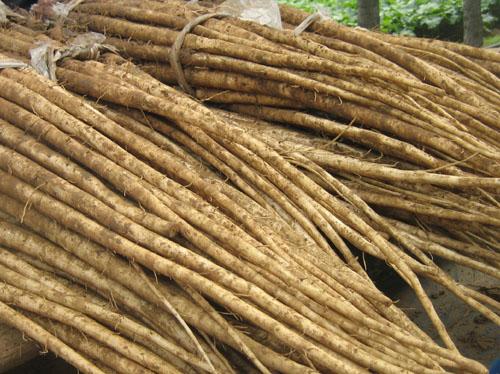Burdock Root

See also : Essiac Tea
Burdock, scientific name Arctium lappa, is a large perennial thistle plant that can grow as high as nine feet. Native to Europe and Asia, it was introduced to North America by the early settlers. It belongs to the daisy family; its folk names include beggar's buttons, cockleburr, bardana and fox's clote. In Japan, its sweet-tasting root is used in foods as well as in herbal preparations. Burdock has been used for hundreds of years as a blood cleanser and purifier. Be sure to discuss using burdock with your healthcare provider before taking it.
Burdock has large green leaves and a rounded head of purple flowers surrounded by a prickly casing that sticks to any who pass close by. Burdock's deep primary root and underground stems, called rhizomes, are harvested along with the seeds to make herbal preparations. The less potent leaves are used to make herbal teas. The plant contains numerous beneficial compounds. According to AltMD, the roots yield up to 45 percent inulin, along with volatile oils, flavonoids and essential fatty acids.
Special Precautions of Burdock Root
Although there is no recommended dosage for burdock, it is considered to be safe when taken in the typical dosage of 2 g of root, according to Drugs.com. Side effects include nausea and diarrhea. Taking burdock in large doses can deplete potassium levels and cause dehydration due to its diuretic effects. If you are allergic to plants in the daisy family, like ragweed and chrysanthemums, you may also have an allergy to burdock. Do not take burdock if you are diabetic or if you are pregnant or breast-feeding, taking other diuretic medication, undergoing chemotherapy or taking other anti-cancer drugs. Belladonna, a poisonous plant, if often mistaken for burdock in the wild, so don't gather your own; only buy burdock products from a reputable manufacturer.
The benefits of Burdock Root are
- Burdock is used as a tonic for its immune-strengthening capabilities. It has been used for centuries as a diuretic and to clear the blood of toxins by stimulating perspiration. When applied topically, it is used to relieve certain skin conditions, such as psoriasis, acne and eczema. Burdock is also being used to lower blood sugar, to treat digestive troubles, minor skin infections, colds, sore throat, flu, HIV and rheumatoid arthritis and to stimulate bile production. Historically, burdock has also been used to treat cancer. There have not been many studies performed on burdock, so evidence of its effectiveness is mostly anecdotal.
- Essiac Tea for Cancer. In the 1920s, nurse Rene Caisse marketed a cancer-fighting herbal preparation containing burdock that was based on a traditional Ojibwa medicine. The exact formula remains secret, but contains burdock, slippery elm, sheep sorrel and Turkish rhubarb. Taken in a tea, it continues to be used as an alternative anti-cancer remedy. The National Cancer Institute states that several reputable scientific studies have found no proof that Essiac is effective in slowing or stopping the growth of cancer cells, and it has not been approved by the FDA as a drug. Consult your doctor before using Essiac or burdock for cancer.